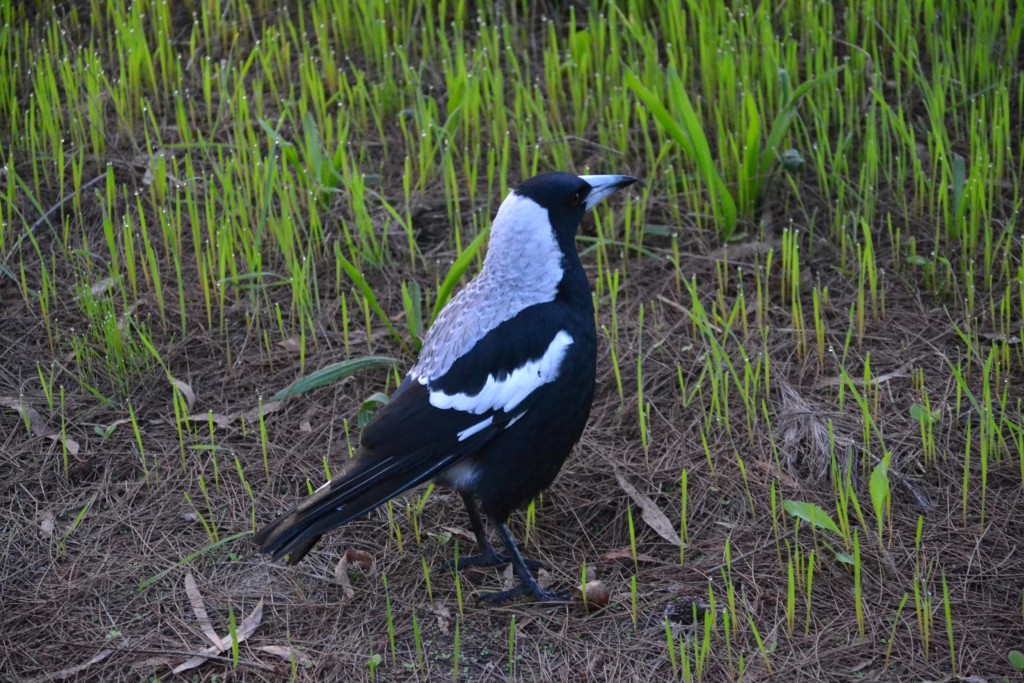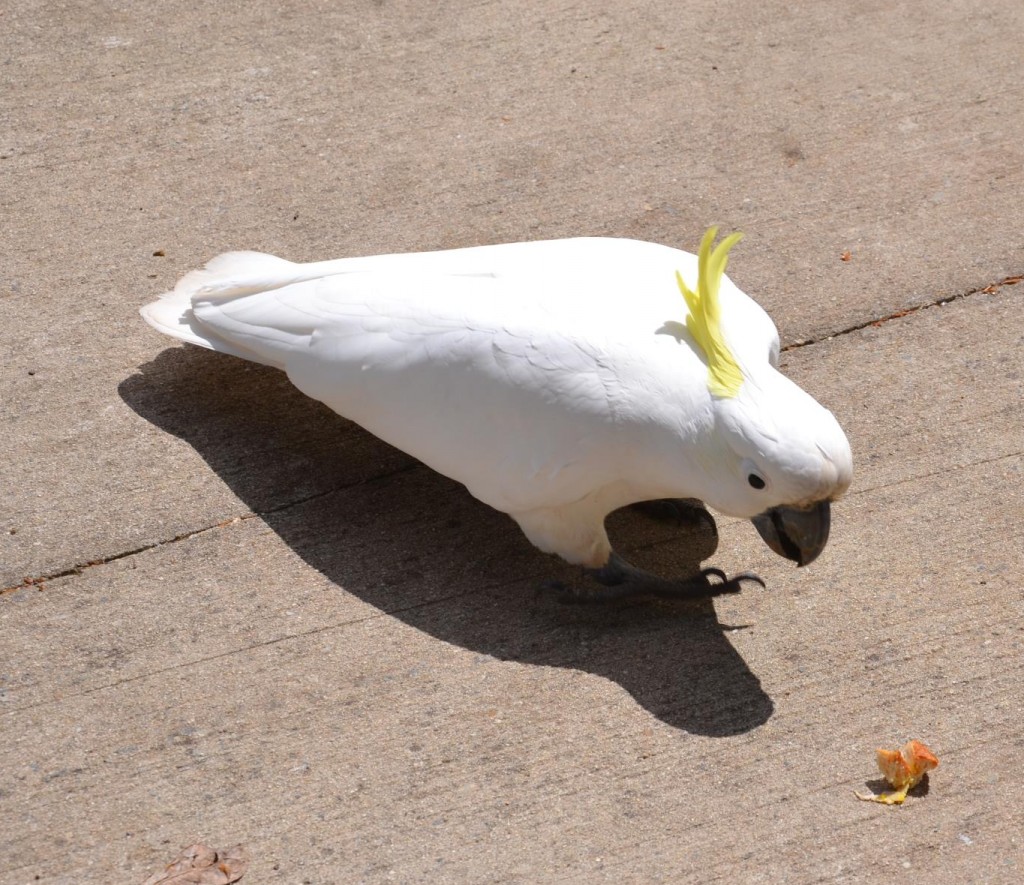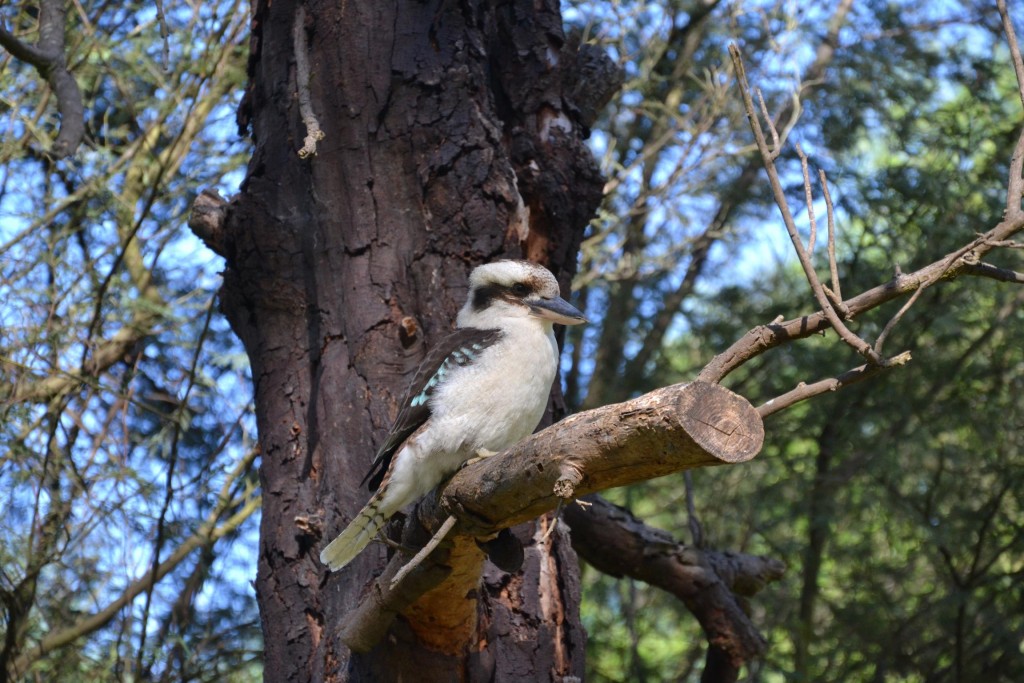Learn English while learning about daily life in Australia, with Rob McCormack
Podcast Number 65 – Common Birds of Melbourne
Hi,
I love to go walking. Luckily, in Australia we have many great walking trails. Melbourne has large areas of national park and grassland which all have great walking trails where you can enjoy the outdoors and get closer to nature. One of the things that makes walking in Australia interesting is the wonderful variety of bird life which you will see. In this podcast, I would like to tell you a little about a few of the birds you will typically see in and around an Australian city like Melbourne. For a full list of suburban Australian birds, you should visit http://www.birdsinbackyards.net/.
The bird I see most often is the Australian Magpie.
This bird is mostly black with some white, especially on the back of the neck. The male has pure white on the back of the neck and the female has a gray colour in this area. The magpie is typically around 30 cm from head to tail and has a long tapering beak. They are found in almost all parts of Australia. Most magpies are not shy at all. For example, you can be walking along a track or footpath and there will often be a magpie searching for insects in the grass next to the path. They especially like a newly mown lawn. Many magpies will stay where they are, even though you walk just a metre away from them. They will usually look at you as you approach to decide if you are going to disturb them. They always seem to have a cheeky look about them and they will sometimes cock their head sideways as you walk quite close to them. They really are cheeky birds. I love the sound the magpies make and to me it is one of the most typically Australian sounds.
Magpies can also cause problems in the breeding season from around September to early November. A small percentage of magpies will swoop anyone who comes near their nest. This means they will dive at you like a dive bomber, trying to peck you in the head. Although very few people are actually injured when they are swooped by a magpie, it is actually quite a scary experience. I can remember being swooped when I was a child and it was terrifying. Nowadays it’s not so scary but even so, I make sure to avoid any area where there is a swooping magpie during the breeding season. It is interesting that one of our most famous Australian Rules Football teams calls themselves the magpies. They are the Collingwood Football Club. Their colours are also black and white (see podcast 2). (Click on this link for more information about the magpie and to hear their wonderful call. http://www.birdsinbackyards.net/species/Cracticus-tibicen.)
Another wonderful and colourful suburban bird is the Galah, one of our Australian parrots. They are pink and gray – an interesting combination. They have a pink chest and neck, gray wings and back and also a wonderful softer pink colour on the top of their head. Their head feathers can also stand up when they are excited, like a tall hat they are putting on. Their beaks are hooked like all parrots, for cracking hard seeds. They are found just about everywhere in Australia and like to fly in large, noisy flocks. It’s great to see them sometimes on the grass verge outside our house. They are generally a little more timid than the magpies and will fly away if you get too close. Interestingly, they mate for life. (Click on this link for more information and to hear the sound of the galah. http://www.birdsinbackyards.net/species/Eolophus-roseicapillus.)
Another bird I see a lot is the Sulphur Crested Cockatoo, also one of our Australian parrots.
They are found down the east side of Australia. They are quite large birds, about 48 cm from head to tail and they make the most incredibly loud screeching sound as they fly from tree top to tree top. It’s like they are shouting at everyone else to be quiet, and yet they are the loudest birds around. Their colouring is very beautiful, with brilliant white feathers and a few splashes of yellow on the top of their head and under their wings. Like the galah, they too will raise the feathers on their head when they are excited. These birds have very strong beaks and have been known to damage the wood on the outside of houses and verandahs. They make a bit of a mess wherever they go, because of their size and their powerful beaks. For example, I have some nice trees in my garden which have large cones on them. After only one visit by a few sulphur crested cockatoos, there were broken branches and the ground around the base of the tree was littered with broken cones. Ah well, I guess the birds own the trees, not me. (Click on this link for more information and to hear the loud screeching sound of the cockatoo.
http://www.birdsinbackyards.net/species/Cacatua-galerita)
One of our most beautiful birds is the Crimson Rosella.
![Crimson Rosella By JJ Harrison (jjharrison89@facebook.com) (Own work) [CC BY-SA 3.0 (http://creativecommons.org/licenses/by-sa/3.0)], via Wikimedia Commons](https://slowenglish.info/wp-content/uploads/2015/09/1024px-Platycercus_elegans_Wilsons_Prom-1024x683.jpg)
Crimson Rosella
By JJ Harrison (jjharrison89@facebook.com) (Own work) [CC BY-SA 3.0 (http://creativecommons.org/licenses/by-sa/3.0)], via Wikimedia Commons
http://www.birdsinbackyards.net/species/Platycercus-elegans)
Last of all, I would like to talk about the Laughing Kookaburra.
These birds are about 40 cm long from head to tail. They live on the east coast, Tasmania and also in south west of Western Australia. Their body is a soft white and their wings are brown. I especially like the brown stripe which goes through their eyes and across the top of their head. Their beaks are tapered like the magpie and when they make their wonderful laughing sound, they turn their heads to the sky as if laughing at the heavens. I sometimes see a kookaburra on my morning walk on the Yarra Trail. He just sits quietly on a branch and looks at me. I wish he would give me his laughing call, but that hasn’t happened as yet. It’s a wonderful sound to hear and, like the magpie’s call, is one of the most typical sounds of Australia.
(Click on this link for more information about this great Australian bird.
http://www.birdsinbackyards.net/species/Dacelo-novaeguineae)
If you have a question or a comment to make, please leave it in the comments box at the bottom of this page. Or, you can send me an email at rob@slowenglish.info. I would love to hear from you. Tell me where you live, a little bit about yourself and what you think of my Slow English podcast. I will write back to you, in English of course. If you would like to take a short quiz to see if you have understood this podcast, you will also find it on my website. Goodbye until next time.
Rob
Podcast 65 Quiz - Did you understand the podcast?
You can take the quiz as many times as you like.
Vocabulary
approach = to come near
attracted = when you want to go towards something or someone
avoid = to stop doing something
beak = the mouth of a bird
branch = the part of the tree where you find the leaves
breeding = when animals are having their young
brilliant = very bright
cheeks = the side of your face
cheeky = a little naughty
cock their head = turn your head a little on its side
combination = when two things are put together
cones = part of a tree where the seeds are found
cracking = to break something hard
damage = when something is broken or destroyed
disturb = when something or someone makes you stop what you are doing
dive bomber = a fighter airplane which dives down to drop bombs
especially = when something is special or stands out from other things
eventually = after a period of time
feathers = the covering on a bird
flocks = a group of many birds
heavens = the sky
hooked = in the shape of a hook or a curve with a sharp end
impressed = when someone really likes something or thinks it is very good
injured = when you are hurt
insects = small animals with 6 legs. For example, a fly, an ant
lawn = an area with grass that has been cut
littered = when things are thrown on the ground
mate = when one animal joins with another animal to have their young
mess = when things not tidy
nature = animals, plants and the outdoors
neck = the part of your body between your head and your shoulders
newly mown = when the lawn has been freshly cut
parrot = a type of bird
peck = when a bird tries to take something with it’s beak
percentage = a term in mathematics which means ‘out of 100’
powerful = strong
pure = is not mixed with anything else
scary = when you are afraid
screeching = very loud, high sound made by an animal
seeds = small parts of a plant, which you put in the ground to grow
shy = when an animal or a person does not like to be seen
splashes = an area of colour
stripe = a wide line
suburban = those parts of the city where the people live, where their houses are
tapering = going from wide down to a narrow point
terrifying = when you are very, very afraid
timid = very shy, often afraid
trails = track or paths you can walk on
trays = a wide plate, usually made of metal
typically = when something is seen many times, average, normal
variety = different types
verandahs = an area attached to a house where you can sit
verge = the space between the footpath and the road
vibrant = bright
wings = used by a bird to fly





July 2, 2021 at 8:50 am
Hello. I am very grateful to you for your amazing podcasts. You love Australia so much and you can feel it in every word you say. You gave me this love and now I love Australia too !!!!
July 3, 2021 at 5:06 pm
Hi Marina,
Many thanks for your comment. You are very kind and I appreciate your feedback. There is a lot to love about Australia, that’s for sure.
I hope you are safe during the pandemic.
Have a great day!
Rob
February 7, 2021 at 8:37 pm
It was great and made me smiling many times.
Thanks Rob.
February 7, 2021 at 10:06 pm
Hi Tatiana,
Thanks for your comment.
Cheers from Melbourne.
Rob
September 26, 2015 at 10:04 pm
G’day. It’s a fabulous podcast, thanks. And it was really interesting to know about Australian fauna. For me the most interesting was to hear the Australian accent. I tend to listen some Australian podcast but it was a little hard to understand you. The pronounciation of ‘brown’ and ‘make’ are new for me.
Thanks again. Keep your great work up.
September 26, 2015 at 10:55 pm
Hi Mikhail,
Many thanks for your kind comment. It is interesting how different countries have different accents. The Australian accent is certainly different to the American and the British English accent. I’m glad you enjoyed the podcast.
Have a great day.
Rob
September 22, 2015 at 10:59 pm
Hi Rob
I loved this podcast too. Of course, the laughing kookaburra was the highlight. It is a shame that we are all so busy to take in our surroundings and appreciate these magnificent birds. Next time I walk the dogs to the park I will be trying to distinguish the male maggies from the female ones. That is if I don’t get swooped first!
September 22, 2015 at 11:25 pm
Hi Paul,
Many thanks for your kind words. I hope you don’t get swooped. It’s amazing how easy it is to differentiate between the male and female magpies. Enjoy the outdoors!
Have a great day.
Rob
September 18, 2015 at 10:25 pm
Hi Rob
Great Podcast. Love the bird photos and the video of the laughing Kookaburra.
Silvia
September 18, 2015 at 10:31 pm
Thanks Silvia. Our birds are certainly a joy to behold. I love that laughing Kookaburra too.
Cheers,
Rob
September 18, 2015 at 10:08 pm
Another great post and photos Rob. For me, the laughing kookaburra is the quintessential sound of the Australia bush but there are so many wonderful birds to choose from, each with their unique characteristics, colors and calls. They are all my favorites.
September 18, 2015 at 10:12 pm
Hi Ray,
Many thanks for your kind comments. Yes, the kookaburra takes the cake. I watched the video about 5 times and each time it made me smile. What a ripper!
Cheers,
Rob